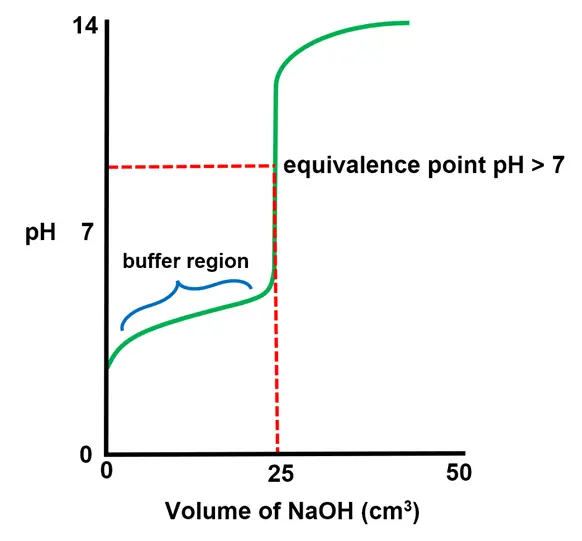General Shapes of pH Curves
- You are conducting a titration experiment, carefully adding a base to an acid (or vice versa).
- Each drop of titrant tells part of a story, and when you plot the pH against the volume of titrant added, you reveal the full narrative: a pH curve.
Key Features of pH Curves
Before diving into specific examples, let’s define the key features of a pH curve:
- Intercept with the pH axis:
- This represents the initial pH of the solution, determined by the strength and concentration of the analyte (the substance being titrated).
- Equivalence point:
- The point where the moles of acid equal the moles of base added.
- The pH at this point depends on the strength of the acid and base.
- Buffer region:
- A relatively flat section of the curve, observed in titrations involving weak acids or bases, where the solution resists changes in pH.
- Points where $ \text{pH} = \text{pKa} $ or $ \text{pOH} = \text{pKb} $:
- These occur halfway to the equivalence point in weak acid-base titrations and are critical for identifying the acid/base strength.
To identify the equivalence point on a pH curve, look for the steepest section of the graph where the pH changes rapidly.
Note- For the acid-base reactions outlined below, keep in mind that the opposite processes can occur.
- For instance, instead of adding a strong acid to the weak base, you can add a weak base to a strong acid.
- Correspondingly, the way the pH graph looks will change as well.
Strong Acid + Strong Base
- The curve starts at a low initial pH(around 1 or lower for a 0.1 M strong acid) because strong acids like HCl or HNO(_3) fully dissociate, producing a high concentration of $ \text{H}^+ $ ions.
- The pH rises gradually at first, then increases sharply near the equivalence point.
- At the equivalence point, the pH is exactly 7, as the neutralization produces only water and a neutral salt (e.g., NaCl from HCl and NaOH).
- After the equivalence point, the pH levels off at a high value(around 13–14) due to the excess strong base.
- For example, consider the titration of 25.0 $cm^3$ of 0.1 M HCl with 0.1 M NaOH.
- The initial pH is 1.00.
- At the equivalence point, exactly 25.0 $cm^3$) of NaOH has been added, and the pH is 7.
- Beyond this, the pH rises steeply due to the excess $ \text{OH}^- $ ions.

Weak Base + Strong Acid
- The curve begins at a high initial pH because the weak base (e.g., ammonia, $NH_3$) only partially ionizes, producing a low concentration of hydroxide ions $OH^-$.
- As the strong acid is added, the pH drops gradually since the weak base reacts incompletely with the $H^+$ ions, forming its conjugate acid (e.g., $NH_4^+$).
- The equivalence point occurs at a pH less than 7 because the conjugate acid formed (e.g., $NH_4^+$) hydrolyzes, releasing additional $H^+$ ions, making the solution slightly acidic.
- Beyond the equivalence point, the pH decreases sharply as excess strong acid dominates the solution, contributing a high concentration of free $H^+$ ions.
- For instance, titrating 25.0 $cm^3$ of 0.1 M $NH_3$ with 0.1 M HCl.
- The equivalence point occurs at a pH around 5.5 because the solution contains $ \text{NH}_4^+ $, which is slightly acidic.
The equivalence point pH reflects the acidic nature of the conjugate acid formed from the weak base.




